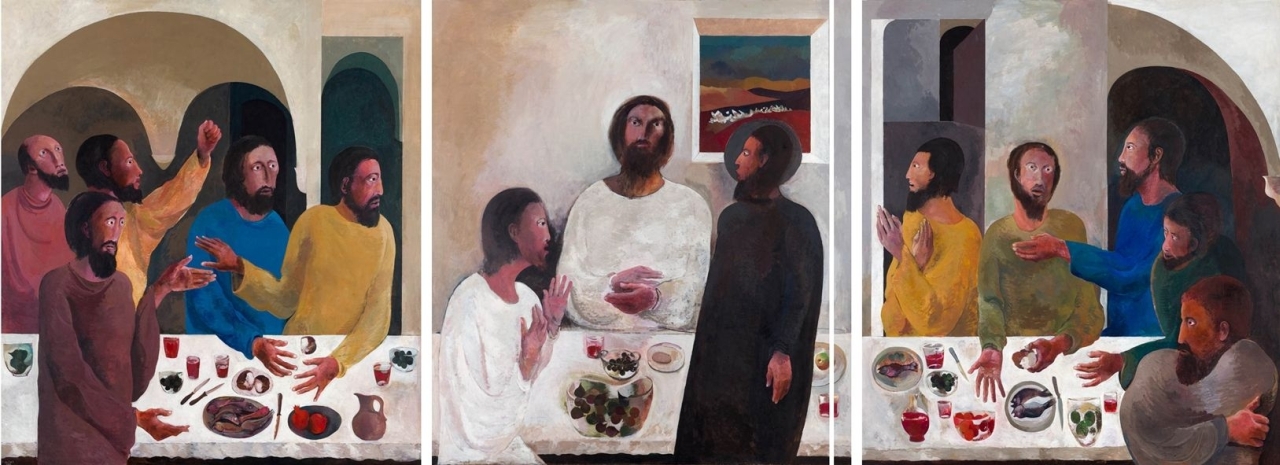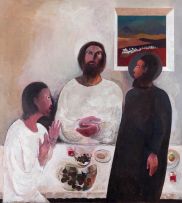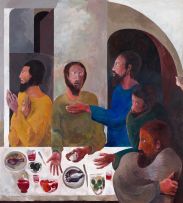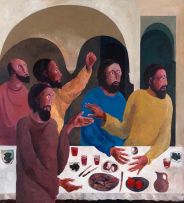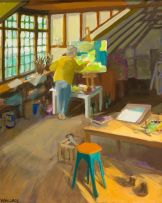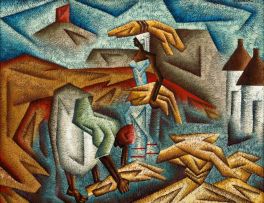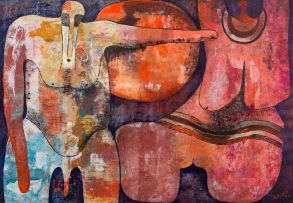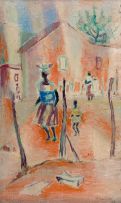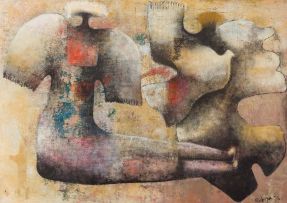Cecil Skotnes
The Last Supper, triptych
Incl. Buyer's Premium & VAT
About this Item
signed and dated 1990
Notes
Accompanied by thirteen preparatory sketches for the triptych; charcoal, pencil and pastel, each: 37,5 by 52,5cm
"On Thursday, 13 December 1990, thirty-three invited guests gathered in the dining hall of Santa Sophia of Pretoria, for a unique celebration. An artist's dream had come true, a hall had been embellished with a mural of The Last Supper, and South Africa had gained a major work of art. To mark the occasion Mass was offered in front of the painting then the guests sat down to a meal at tables arranged to link up with the great table depicted on the wall. Thus Christ and his twelve disciples (for Judas was still present) were the guests of honour at the feast.
Since the mid-forties it had been Cecil Skotnes's dream to paint a Last Supper. In 1989 the Trustees of Santa Sophia 'gave' him a wall on which to realise his dream. Although he had thought of such a painting for the best part of his career, and indeed incorporated some of his ideas in woodcuts, engraved panels and paintings, he now began to work on it seriously. Drawing after drawing came from his pencil as he read about the apostles and pondered on their characters. From the outset of his career in much of his art a preoccupation with the conflict between good and evil is paramount. In his depiction of The Last Supper this confrontation is the focus and pivot of the entire painting.
The mural consists of three panels joined to form one continuous composition. In the left panel are Bartholomew (identified by a fig in a glass jar), an explosive James the Greater, Andrew, Matthew and, in front of the table, Simon the Zealot ready for a fight. In the centre are John, Jesus and Judas. Judas has a black halo to indicate that he, at this moment, has already made his decision. The other apostles have no haloes because, as the artist explains, at that time 'they had not yet earned them'. In the left panel are James the Little, Phillip pointing to the bread and fish of the miracle, Jude, Thomas and Simon Peter.
Except for Philip, all the disciples are watching the drama being enacted at the centre. All are agitated. Some, like James the Greater and Simon the Zealot, respond aggressively; John is astounded; Peter is restraining his outrage with great physical effort; James the Little and Philip are bewildered; Matthew is alert, warning Andrew to listen. Only Jesus is still, aloof from the commotion.
From the drawings we learn that the confrontation between Jesus and Judas is over, and in his defeat Judas transfers his belligerence to John and the other disciples. But Jesus looks straight ahead, beyond his disciples, beyond the modern viewer, even beyond this world, towards the New Jerusalem."1
1 Frieda Harmsen, written for the Trefoil Easter, 1993
Provenance
Santa Sophia, the Institute for Catholic Education, Pretoria
Literature
Harmsen, Frieda. The Art at Santa Sophia. Joan Lötter Publications, Pretoria, 2002, illustred in colour on pages 34-38, preparatory drawings no. 1, 9, 11,15 and 16 illustrated on pages 40-47
Harmsen, Frieda (ed.). Cecil Skotnes. Privately Published, Pretoria, 1996, triptych and preparatory drawings illustred on pages 147-166
